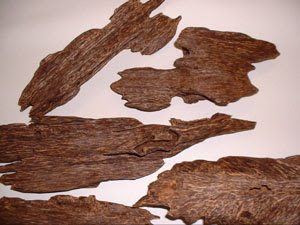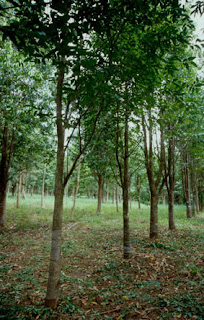
Aquilaria hirta Ridl.
Distributes in Malay Peninsula (Trengganu, Pahang, Johore), Singapore and east Sumatra (Senamaninik), Riau and Lingga islands. This species grows on hill slopes, from the lowland up to 300 m.
Aquilaria microcarpa BaillDistributes in Malay Peninsula, Sumatra (Sijunjung, Palembang and Lampung), Belitung, Bangka and throughout Borneo. Grows on lowland forest up to 200 m
Aquilaria cumingiana (Decne) RidlDistribution areas: South Borneo (Sampit region), Philippines (common), and Moluccas (Morotai and Halmahera), in primary forest at low and medium altitudes.
 Aquilaria grandiflora Bth.
Aquilaria grandiflora Bth.Distribution area China
Aquilaria secundana D.C.Distribution area Moluccas
Aquilaria moszkowskii GilgDistribution area Sumatra
Aquilaria tomentosa GilgDistribution area New Guinea
Aqularia baillonii Pierre ex LecomteDistribution area Cambodia
Aquilaria sinensis Merr.Distribution area China
Aquilaria apiculata Merr.Distribution area Philippines (Mindanao)
Aquilaria acuminate (Merr.)Quis. Distribution area Philippine
Aquilaria yunnanensis S.C. HuangDistribution area China
Gyrinops versteegii (Gilg.) DomkeDistribution areas: Lesser Sunda Islands (Lombok, Sumbawa, Flores, Sumba); North Celebes (Minahasa) and West New Guinea. This species scattered from the lowland up to 900 m. This species closely related to Gyrinops podocarpus which also found in West New Guinea
Gyrinops moluccana (Miq.) Baill. Distribution area Buru and Halmahera, in rain-forest
Gyrinops decipiens Ding HouDistribution area Central Celebes (Wavatoli, Palarahi), in rain-forest, 100 m.
Gyrinops ledermanii DomkeDistribution area New Guinea (Sepik R., Mt. Pfingst), at slope in dense virgin forest, foot of the mountain, at 0-200 m
Gyrinops salicifolia Ridl.Distribution area Western New Guinea (Utakwa, Nabire), in fringing rain-forest, 300 m.
Gyrinops audate (Gilg) DomkeDistribution area New Guinea (Sidai, Mt. Arfak) at primary forest 5-20 m.
Gyrinops podocarpus (Gilg.) Domke
Distribution area West New Guinea (Ramoi, Sorong, Monep, Idenburg), in primary forest, from lowland up t Distribution area Distribution area 750m.


 Agarwood, aloeswood, eaglewood, jinkoh, gaharu are names for the world’s most valuable incense. This resinous material is produced by tropical rainforest trees and has been used for centuries as incense and in traditional medicine. In the past, old growth Aquilaria and Gyrinops trees were indiscriminately cut to find the resin (usually hidden within the center of only a few old trees). Today in many countries of Southeast Asia where the tree was once native, it has become very rare due to increased harvesting. The resinous wood or oil extracted from the inside of some trees is extremely valuable since it is highly regarded for use during Buddhist and Islamic cultural activities as well as an important ingredient in many traditional medicines. It is also an extremely important component in traditional Japanese incense ceremonies. Although most people in the United States and Europe are not familiar with this aromatic resinous wood, its use as incense (called aloeswood) is mentioned several times in the bible. People in the United States, Europe and other countries that have had the opportunity to smell the fragrance of this extraordinary incense find it very appealing and pleasant.
Agarwood, aloeswood, eaglewood, jinkoh, gaharu are names for the world’s most valuable incense. This resinous material is produced by tropical rainforest trees and has been used for centuries as incense and in traditional medicine. In the past, old growth Aquilaria and Gyrinops trees were indiscriminately cut to find the resin (usually hidden within the center of only a few old trees). Today in many countries of Southeast Asia where the tree was once native, it has become very rare due to increased harvesting. The resinous wood or oil extracted from the inside of some trees is extremely valuable since it is highly regarded for use during Buddhist and Islamic cultural activities as well as an important ingredient in many traditional medicines. It is also an extremely important component in traditional Japanese incense ceremonies. Although most people in the United States and Europe are not familiar with this aromatic resinous wood, its use as incense (called aloeswood) is mentioned several times in the bible. People in the United States, Europe and other countries that have had the opportunity to smell the fragrance of this extraordinary incense find it very appealing and pleasant. Aquilaria trees are now protected in most countries and the collection of agarwood is illegal from natural forests. International agreements, such as CITES (the Convention on International Trade in Endangered Species of Wild Fauna and Flora), accepted by 169 countries, is designed to ensure trade in agarwood products from wild trees does not threaten the survival of Aquilaria. Despite these efforts agarwood products from illegally cut trees continues to be sold and unknowing consumers create a demand that helps to destroy the last old growth Aquilaria trees in existence.
Aquilaria trees are now protected in most countries and the collection of agarwood is illegal from natural forests. International agreements, such as CITES (the Convention on International Trade in Endangered Species of Wild Fauna and Flora), accepted by 169 countries, is designed to ensure trade in agarwood products from wild trees does not threaten the survival of Aquilaria. Despite these efforts agarwood products from illegally cut trees continues to be sold and unknowing consumers create a demand that helps to destroy the last old growth Aquilaria trees in existence. What triggers agarwood to form in some old growth trees has been an unsolved mystery. Our research investigation over the last 12 years in cooperation with The Rainforest Project Foundation, a nonprofit organization dedicated to the preservation of the worlds forests http://www.agarwood.org.vn, has studied the formation of resin in Aquilaria and Gyrinops trees and found a method to produce the resin in plantation grown young trees. This technique consists of wounding trees in a specific manner and applying treatments to accelerate the natural defense responses of the tree. The technique allows a sustainable yield of resin to be produced in relatively young trees. Agarwood is a high value forest product that is easy to store and ship. Our newly developed methods to cultivate agarwood is providing a new economic, non-timber forest product for Southeast Asia and other tropical regions of the world. This new economy in rural areas will help many of the world’s poorest people. The sustainable production of agarwood in plantation grown trees eliminates the need to cut old growth forest trees for the resin and will help save this endangered tree from possible extinction. This work also provides a source of cultivated agarwood so this magnificent aromatic resin can be enjoyed by people throughout the world. The world's first cultivated agarwood produced using our technology by farmers in Vietnam is now available and can be purchased from distributers and from the internet.
What triggers agarwood to form in some old growth trees has been an unsolved mystery. Our research investigation over the last 12 years in cooperation with The Rainforest Project Foundation, a nonprofit organization dedicated to the preservation of the worlds forests http://www.agarwood.org.vn, has studied the formation of resin in Aquilaria and Gyrinops trees and found a method to produce the resin in plantation grown young trees. This technique consists of wounding trees in a specific manner and applying treatments to accelerate the natural defense responses of the tree. The technique allows a sustainable yield of resin to be produced in relatively young trees. Agarwood is a high value forest product that is easy to store and ship. Our newly developed methods to cultivate agarwood is providing a new economic, non-timber forest product for Southeast Asia and other tropical regions of the world. This new economy in rural areas will help many of the world’s poorest people. The sustainable production of agarwood in plantation grown trees eliminates the need to cut old growth forest trees for the resin and will help save this endangered tree from possible extinction. This work also provides a source of cultivated agarwood so this magnificent aromatic resin can be enjoyed by people throughout the world. The world's first cultivated agarwood produced using our technology by farmers in Vietnam is now available and can be purchased from distributers and from the internet.








































